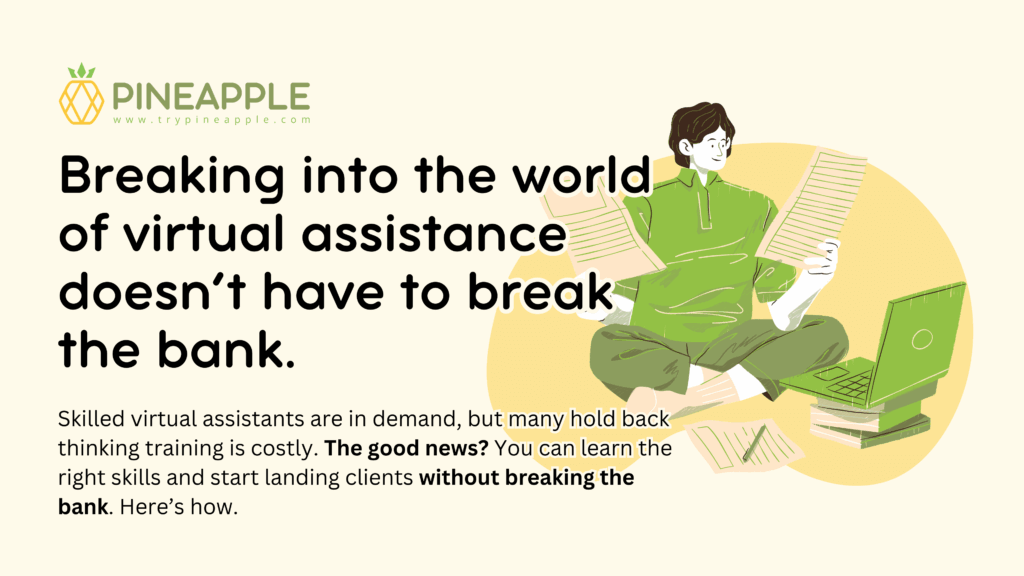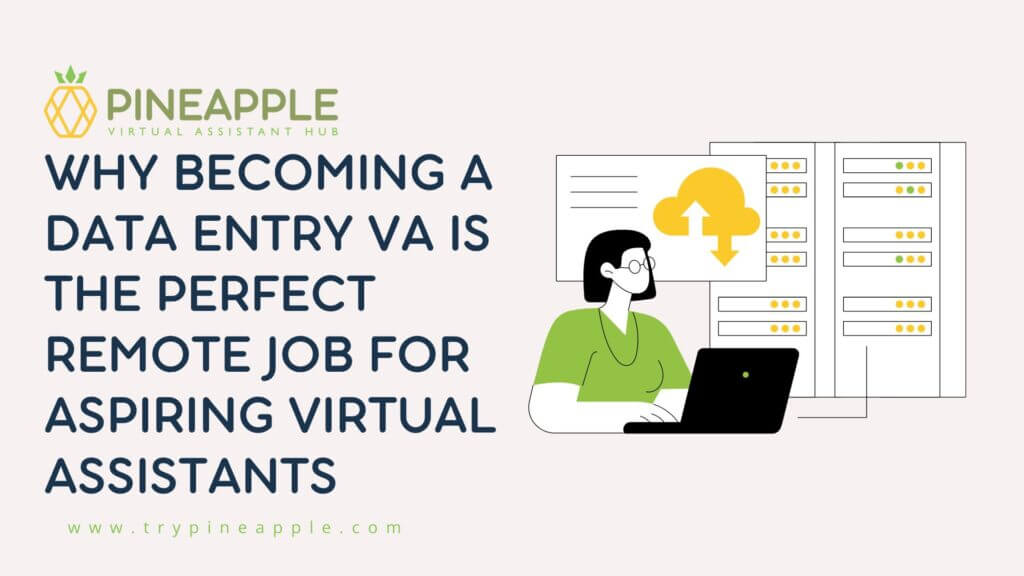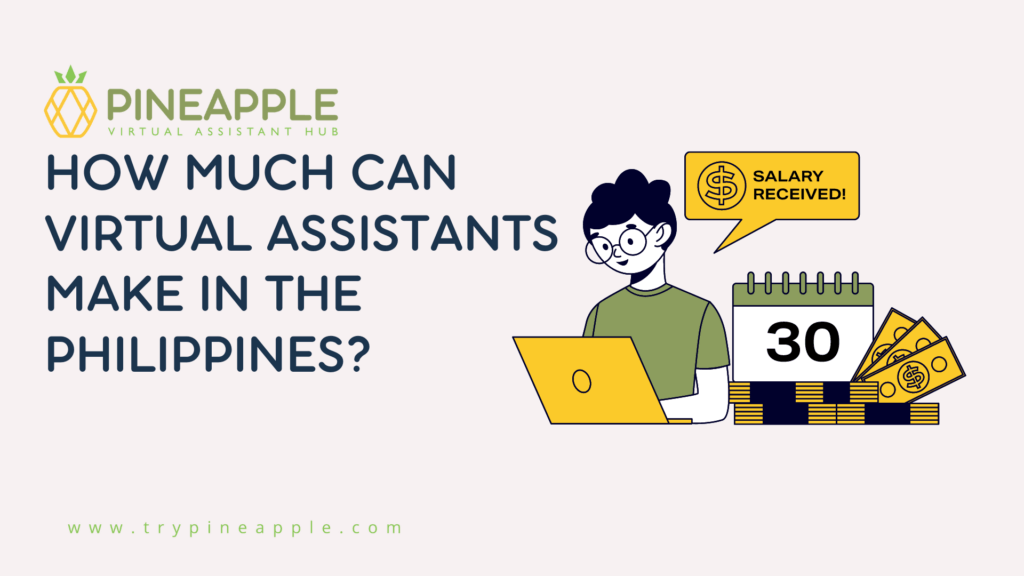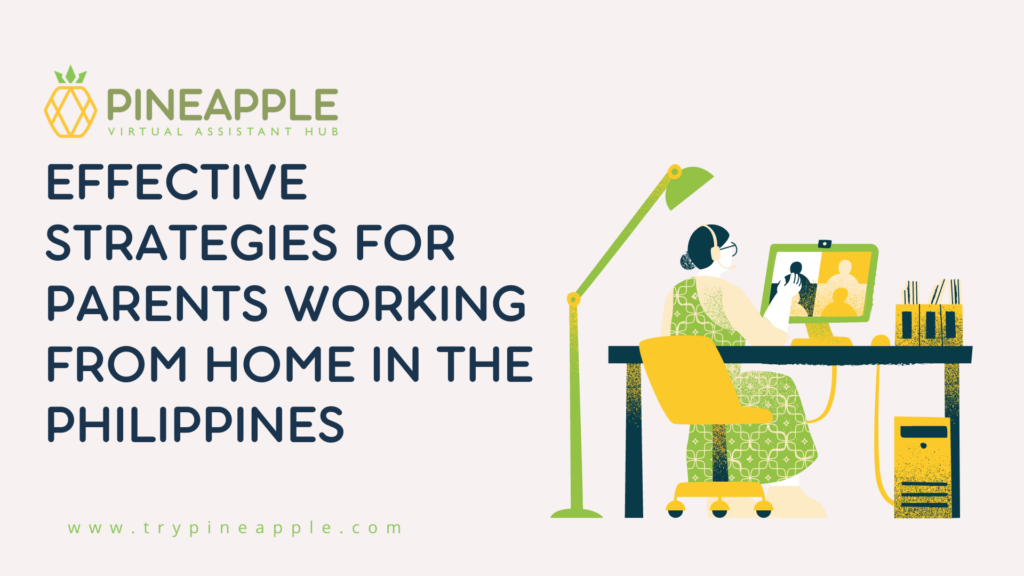The virtual assistant industry is booming and this should come as no surprise. As more entrepreneurs, small businesses, and even large enterprises embrace remote work, the demand for skilled virtual assistants continues to increase. But this also means that the industry is highly competitive. So, if you want to land amazing clients and maintain a competitive edge, you need the right set of skills. However, if you’re just starting out, you may be wondering how to get virtual assistant training without emptying your bank account.
The good news is that you don’t have to spend your life savings. In fact, there’s an abundance of free and affordable resources online which can help you kickstart your virtual assistant career. To give you a head start, Pineapple has put in the groundwork to uncover all the best platforms and strategies for learning virtual assistant skills for free (or on the cheap), so you can hit the ground running.
What Is a Virtual Assistant? And Why Does Training Matter?
Before we dive into the virtual assistant training resources you need, it’s important to understand exactly what it is a virtual assistant does. And you also need to know why investing your time in learning the right skills is crucial.
A virtual assistant is a remote professional who provides support services to businesses, entrepreneurs, or busy professionals. Working from anywhere in the world, thanks to the power of high-speed internet connections, a virtual assistant can take on duties ranging from administrative through to technical and creative, it all depends on the client’s needs. Some of the more common virtual assistant tasks include:

 Calendar scheduling
Calendar scheduling




There are also countless niche services such as podcast editing, CRM management, and e-commerce support which require the talents of a virtual assistant. Again, it depends entirely on the client – and with more and more businesses turning to virtual assistants, this range of niches is only going to grow.
As the virtual industry is so broad, and with so many new virtual assistants entering it every day, clients are on the lookout for professionals who are trained, confident, and capable of handling tasks efficiently. Even if you're only offering general services, having a solid background and knowledge of tools, processes, and communication best practices can set you apart from your rivals. Regardless of whether you’re self-taught, certified, or still learning, actively engaging with virtual assistant training highlights that you take your work seriously.
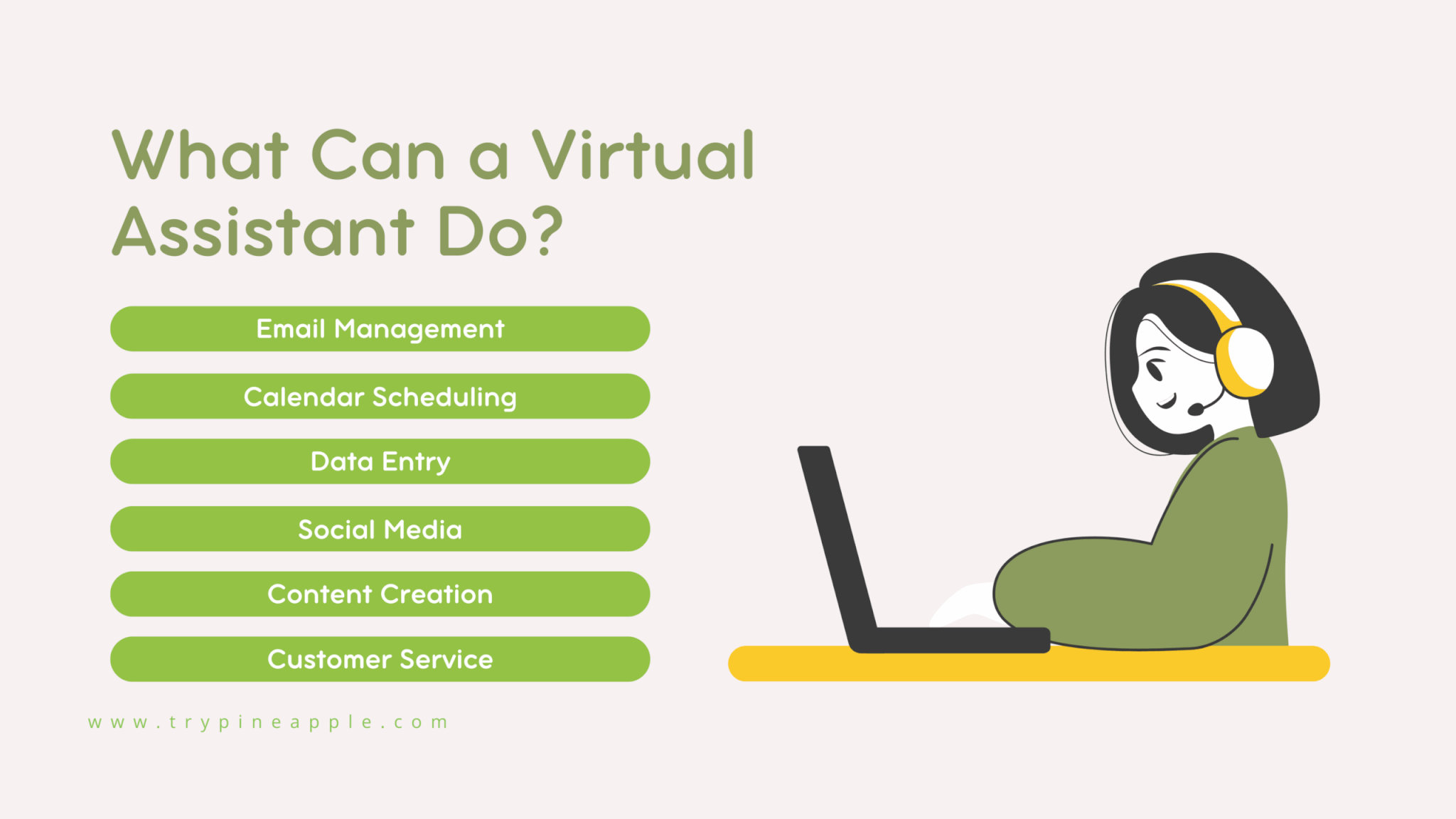
What are the Core Skills a Virtual Assistant Needs?
If you want to stay competitive in the virtual assistant industry - and stand out to potential clients, these are the core skills you need to master:
Time Management and Organization:
Efficient time management skills are the backbone of any successful virtual assistant. You need to ensure tasks are completed swiftly, while using your strong organizational skills to prioritize responsibilities and avoid being overwhelmed.
Communication:
Clear, professional communication is vital for building trust with clients and maintaining strong, smooth workflows. From composing emails, updating clients, or taking part in virtual meetings, you have to convey information accurately, actively question, and know the right questions to ask.
Project Management Tools:
Getting to grips with tools such as Asana and Trello enables you to collaborate efficiently, track progress, and stay organized. These tools can help you break projects down into actionable tasks, assign due dates, and provide clear visibility across ongoing projects with minimal confusion.
Office Software:
Mastering standard office software - such as Microsoft Office and Google Workspace - is one of the most fundamental skills you need. Clients will frequently need you to use word processors, spreadsheets, and presentation tools, so developing an expertise here is critical for your success.
Graphic Design:
Client branding and content needs strong, appealing visuals to really make it sing. This is why virtual assistants with even basic design skills are in demand. A competent virtual assistant will be able to craft social media posts, marketing materials, and eye-catching presentations using user-friendly platforms like Canva and Adobe Express.
Social Media Platforms:
Social media marketing is crucial in modern business and virtual assistants need to be able to carefully manage their clients’ online presence. Accordingly, you need to understand social media platforms and using scheduling tools like Buffer or Later to execute successful marketing campaigns and engage users.
Email Marketing:
As a virtual assistant, you should be comfortable setting up campaigns, managing subscriber lists, and analyzing performance metrics. Mailchimp and Kit are two common platforms which successful virtual assistants use to design emails, schedule campaigns, and support client marketing goals.

Free and Low-Cost Platforms for Virtual Assistant Training
The sheer number of skills you need to master can appear intimidating, especially if you start trying to calculate how much all of this learning will cost. Fortunately, you don’t need the pockets of a billionaire to develop virtual assistant expertise. In fact, virtual assistant training is often free or more than affordable. Some of the best options you can explore are:
YouTube:
Perhaps the most straightforward option for virtual assistant training, YouTube is accessible to everyone, yet remains underrated. On YouTube, an aspiring virtual assistant can find tutorials for everything they could possibly need. With thousands of free tutorials covering everything from managing a client’s inbox to mastering tools like Canva or Asana, you can easily learn from established virtual assistants and business coaches for free.
Coursera:
Offering professional, university-backed courses, Coursera takes in modules such as time management, business writing, and digital marketing. Many of the courses on offer are free to audit, so you can access the learning materials at no cost - you’ll only pay if you want a certificate. Courses like Google Project Management and Work Smarter with Microsoft Excel are particularly helpful for virtual assistants who want to build strong business and technical skills
Udemy:
Udemy is known for offering affordable, one-time payment courses that often go on sale, with prices sometimes dropping as low as $10 - $20. If you want to start building a strong knowledge in areas such as time management, customer support, and bookkeeping, Udemy is the place to head. Best of all, if you purchase a course, you have lifetime access to it - perfect for refreshing your skills as your career evolves.
HubSpot Academy:
If you’re looking for a treasure trove of virtual assistant training resources, HubSpot Academy will be the perfect place for you. Their free certifications covers vital business skills such as email marketing, social media strategy, and inbound sales. All of these skills, as well as many others which HubSpot Academy offer, are highly relevant for virtual assistants working with startups, agencies, or entrepreneurs.
Google Digital Garage:
Digital skills are critical in modern business, so developing and enhancing these skills should be one of your priorities. But how do you get started? Luckily, Google Digital Garage provides a variety of free online courses designed to improve your digital skills. From learning the fundamentals of Digital Marketing, understanding how to utilize productivity Tools, and project management, all the building blocks of a successful virtual assistant career are available.
Skillshare:
Although it’s a paid platform, Skillshare frequently offer free trials for a month, giving you time to explore and complete multiple courses. And the seemingly endless number of courses on offer cover skills such as writing, productivity, and design topics. As for virtual assistant training, classes focused on tools like Asana, Canva, and Microsoft Office stand out as particularly useful. Another benefit of Skillshare is that it has a project-based approach, encouraging aspiring virtual assistants to practice what they learn.
Facebook Groups:
While not a traditional learning platform, Facebook Groups centered around virtual assistants can prove invaluable for career development. Members often share job leads, signpost each other to free virtual assistant training opportunities, templates, and provide feedback on portfolios or service packages. Being part of an active virtual assistant community keeps you up to date with industry trends and helps you stay motivated.
Free eBooks and PDFs:
One of the best resources for self-paced reading and reference material comes in the form of free eBooks and PDFs. Many successful virtual assistants and digital entrepreneurs are keen to share their knowledge and offer downloadable guides and eBooks on their websites. Just search Google for free virtual assistant eBooks and you’ll quickly gain access to a rich seam of resources for your learning journey.
Alison:
Another free learning platform, Alison gives you access to a variety of certificate and diploma courses. Topics on offer include administrative support, time management, communication skills, and project planning - all essential niches for virtual assistants who want to stand out to potential clients. It’s important to note, however, that while the learning content is free, you do need to pay a small fee if you want to download an official certificate. Nonetheless, it’s ideal for those just getting started with their virtual assistant training.
How Do You Structure Your Virtual Assistant Training?
When you’re starting out in the virtual assistant world, you’re faced with numerous challenges. In terms of virtual assistant training, the challenge is knowing which skills to learn and how to organize your training. Without a plan, it’s easy to spend all your time watching tutorials without putting any of this learning into practice. Therefore, you need to follow this roadmap to give structure to your learning:
Identify Your Niche:
Is there a particular area you feel you can thrive in? Are you drawn to social media, admin tasks, bookkeeping, or some other niche? Undertaking virtual assistant training in a niche you can engage with is vital for prolonged success.
Pick a Platform for Learning:
It’s best to start with free platforms like YouTube and Coursera to get a taste of the skills you need to utilize as a virtual assistant. If you feel energized by this learning, consider investing in a paid platform such as Coursera.
Create a Learning Schedule:
Consistency is key when it comes to learning, so creating a learning schedule you can stick to is paramount. Aim for at least 3-5 hours per week to consolidate your learning and make progress.
Apply Your Skills:
Once you’ve started to develop your skills, put them into practice by doing mock projects, offering help to friends, or using freelance sites like Upwork to get real-world experience and feedback.
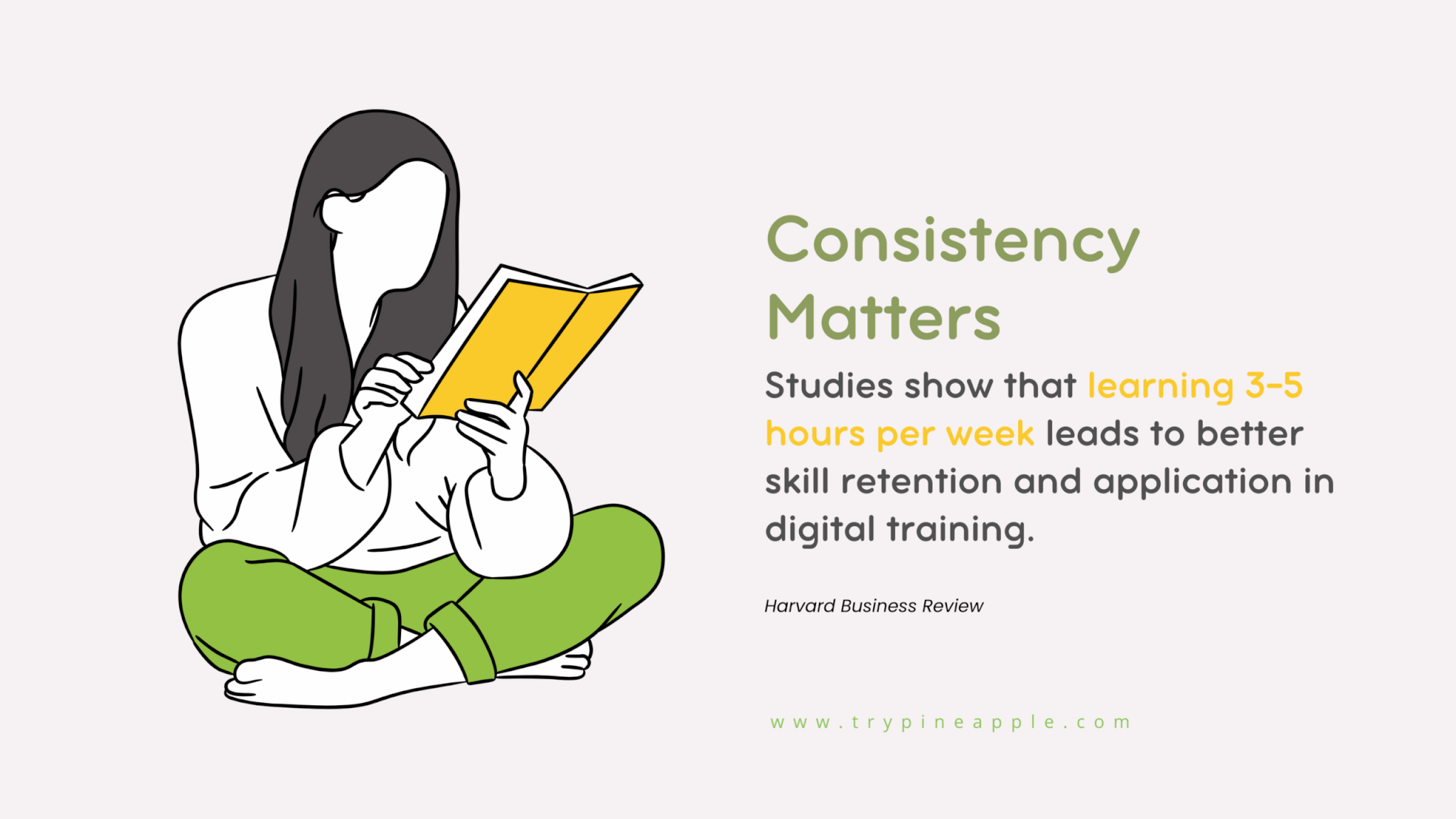
Becoming the Best Virtual Assistant You Can
Virtual assistant training is a non-negotiable step in becoming an in-demand virtual assistant. Here at Pineapple, we can instantly spot an amazing virtual assistant, and they always have one thing in common: a history of extensive training. So, once you’ve started building your skillset and feel ready to connect with a fantastic client base, get in touch with us by clicking here.
Be Part of The Pineapple Family
Start Your Virtual Assistant Career with Pineapple. We are always in the look out for the best Filipino virtual assistant. Join us in a mission to ensure that startups, small business owners, and entrepreneurs achieve the sweet taste of success!

